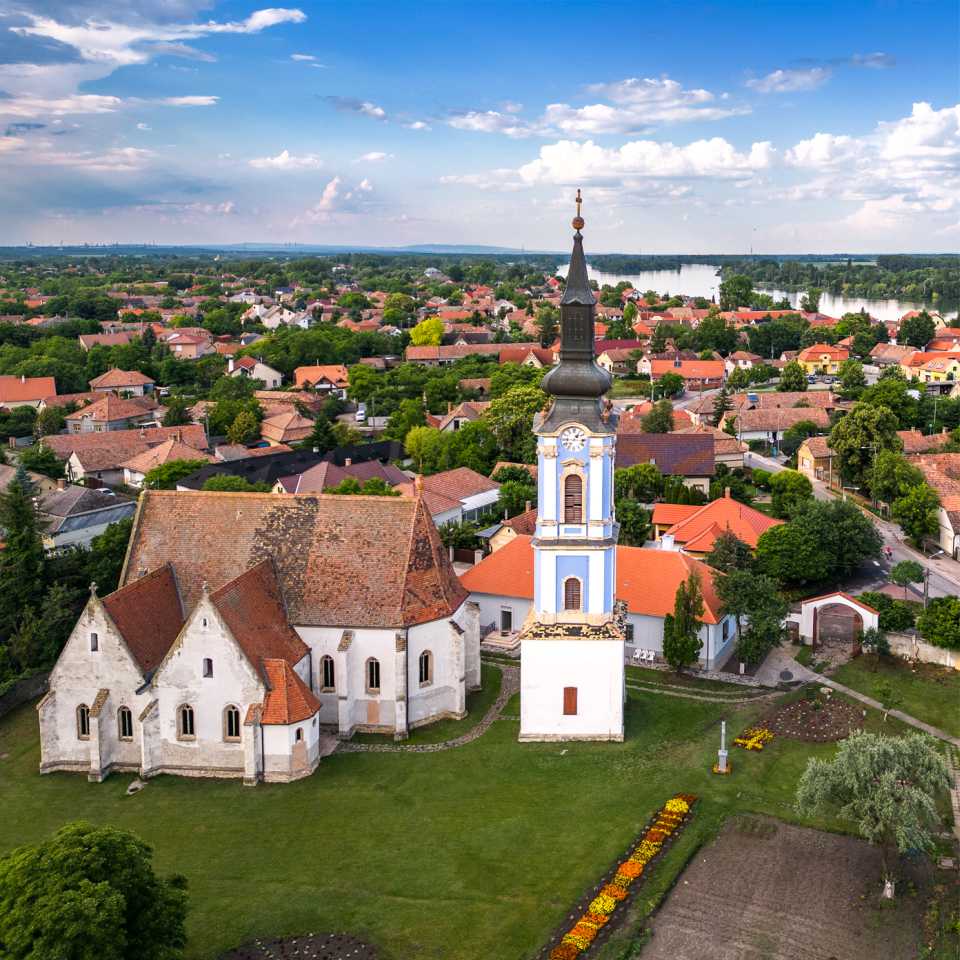
Serbian Kovin
Monastery
The Monastery of the Dormition of the Holy Mother of God in Serbian Kovin (Ráckevei Kolostor, The Serbian Kovin Monastery) is a unique monument of Orthodox spirituality and Serbian cultural heritage in Hungary. Located on Csepel Island, about 40 km south of Budapest, it is both the oldest preserved Serbian Orthodox foundation on Hungarian soil and the only monastery of its kind in the country — making it an invaluable landmark in both spiritual and architectural terms, and the earliest and most important point in the history of the Diocese of Buda.
Origins and History
According to preserved oral tradition and local museum sources, the monastery’s origins date back to the early Middle Ages. Tradition connects its founding to Queen Helena of the Vukanović dynasty, daughter of the Serbian Grand Župan Uroš I and wife of Hungarian King Béla II the Blind. During the reign of her underage son, Géza II (1141–1161), Queen Helena governed Hungary — a period to which the monastery’s beginnings are often attributed.
While this story belongs to the realm of sacred memory rather than verified fact, it remains a deeply valued part of the monastery’s heritage, preserved by the Serbian Church Museum in Szentendre. Historical research and archival records, on the other hand, point to later centuries and to the migration of Serbian refugees during the 15th century, when many fled Ottoman expansion and settled in the Csepel area.
These settlers, arriving from the southern Serbian town of Kovin after its devastation by the Turks in 1439, found here an existing monastic site and adopted it as their new spiritual home. From that time on, “Serbian Kovin” became both a place name and a symbol of the community’s perseverance in faith and identity. The church, dedicated to the Dormition of the Mother of God, with chapels of St John the Forerunner and Sts Cosmas and Damian, became the spiritual center of this Serbian enclave and a living testimony to the merging of Eastern piety and Western Gothic style.
During the reign of Empress Maria Theresa, many monasteries within the Habsburg Empire were suppressed as part of imperial reforms. In 1777, Serbian Kovin was among those closed, and its small brotherhood transferred to nearby Grabovac Monastery. The church continued to function as a parish temple, preserving its sacred role even without monastic life — a pause that lasted for more than two centuries. Only in modern times was the monastery restored to its full status, marking the rebirth of monastic life among the Serbian Orthodox community in Hungary.
Architecture
One of the monastery’s most remarkable features is its architectural synthesis — a rare blend of Gothic structure and Orthodox interior. Frescoes, icons, and baroque-Byzantine ornamentation coexist with pointed arches and stained glass, creating a space where East and West meet in harmony.
Inscriptions preserved within the church record three major painting phases — from 1320, 1514, and finally 1765. The surviving 18th-century frescoes and iconostasis were created by the workshop of Theodor Simeonov Gruntović, a Balkan master painter. The carved and gilded wooden furnishings, made around the same time, enrich the church’s interior, while the revered icon of the Virgin Mary — a 17th-century work — occupies the central place on her throne on the northern side of the nave.
Spiritual and Cultural Significance
As the only Serbian Orthodox men’s monastery in Hungary, and indeed the only Orthodox monastery of any kind in the country, Serbian Kovin holds a special place in the religious and cultural life of the region. It stands as the oldest surviving monument of Serbian culture in Hungary and the most important monastic center of the Serbian diaspora in Europe.
Its mission transcends national borders: to preserve spiritual heritage and Serbian identity, to serve as a bridge between homeland and diaspora, and to present the Orthodox faith and culture to visitors of all backgrounds. Serbian Kovin today is an international spiritual meeting point — a place where believers, pilgrims, and scholars gather to experience the living tradition of Orthodoxy in Central Europe.
The Wonderworking Icon
A central treasure of the monastery is the Wonderworking Icon of the Mother of God of Kovin, venerated for centuries as the most sacred Serbian icon in Hungary and one of the most important relics of the Serbian diaspora in Europe. Numerous stories of healings and miracles are linked to it, and the faithful have offered silver votive gifts as tokens of gratitude for divine help.
The feast of the Mother of God of Kovin, celebrated each year on May 25, gathers believers from Hungary, Serbia, and across the diaspora — transforming the monastery into a place of unity, renewal, and consolation. The monastery also keeps the holy relics of St Justin of Ćelije and Vranje (1894–1979), one of the greatest Orthodox theologians of the 20th century, and of St Methodius, Enlightener of the Slavs (†885), thus maintaining a living connection with the entire Orthodox world.
